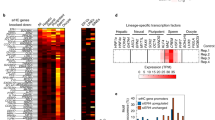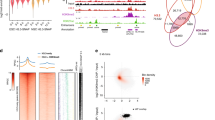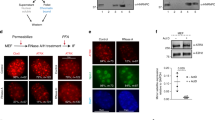Abstract
Heterochromatin is important for genome integrity and stabilization of gene-expression programs. We have identified the transcription factors Pax3 and Pax9 as redundant regulators of mouse heterochromatin, as they repress RNA output from major satellite repeats by associating with DNA within pericentric heterochromatin. Simultaneous depletion of Pax3 and Pax9 resulted in dramatic derepression of major satellite transcripts, persistent impairment of heterochromatic marks and defects in chromosome segregation. Genome-wide analyses of methylated histone H3 at Lys9 showed enrichment at intergenic major satellite repeats only when these sequences retained intact binding sites for Pax and other transcription factors. Additionally, bioinformatic interrogation of all histone methyltransferase Suv39h–dependent heterochromatic repeat regions in the mouse genome revealed a high concordance with the presence of transcription factor binding sites. These data define a general model in which reiterated arrangement of transcription factor binding sites within repeat sequences is an intrinsic mechanism of the formation of heterochromatin.
This is a preview of subscription content, access via your institution
Access options
Subscribe to this journal
Receive 12 print issues and online access
$189.00 per year
only $15.75 per issue
Buy this article
- Purchase on Springer Link
- Instant access to full article PDF
Prices may be subject to local taxes which are calculated during checkout







Similar content being viewed by others
Accession codes
Change history
27 December 2012
In the version of this article initially published, Simone Meidhof's affiliations should have included Spemann Graduate School of Biology and Medicine (SGBM), Albert Ludwigs University Freiburg, Freiburg, Germany and the Faculty of Biology, Albert Ludwigs University Freiburg, Freiburg, Germany. Acknowledgement of the Excellence Initiative of the German Research Foundation (GSC-4, Spemann Graduate School) was omitted. The errors have been corrected in the HTML and PDF versions of the article.
References
Allshire, R.C. & Karpen, G.H. Epigenetic regulation of centromeric chromatin: old dogs, new tricks? Nat. Rev. Genet. 9, 923–937 (2008).
Henikoff, S., Ahmad, K. & Malik, H.S. The centromere paradox: stable inheritance with rapidly evolving DNA. Science 293, 1098–1102 (2001).
Vissel, B. & Choo, K.H. Mouse major (γ) satellite DNA is highly conserved and organized into extremely long tandem arrays: implications for recombination between nonhomologous chromosomes. Genomics 5, 407–414 (1989).
Garagna, S., Zuccotti, M., Capanna, E. & Redi, C.A. High-resolution organization of mouse telomeric and pericentromeric DNA. Cytogenet. Genome Res. 96, 125–129 (2002).
Allis, C.D., Jenuwein, T., Reinberg, D. & Caparros, M.-L. Epigenetics Ch. 3, 23–61 (Cold Spring Harbor Laboratory Press, 2007).
Lachner, M., Sengupta, R., Schotta, G. & Jenuwein, T. Trilogies of histone lysine methylation as epigenetic landmarks of the eukaryotic genome. Cold Spring Harb. Symp. Quant. Biol. 69, 209–218 (2004).
Grewal, S.I. & Elgin, S.C. Transcription and RNA interference in the formation of heterochromatin. Nature 447, 399–406 (2007).
Martienssen, R.A., Kloc, A., Slotkin, R.K. & Tanurdzic, M. Epigenetic inheritance and reprogramming in plants and fission yeast. Cold Spring Harb. Symp. Quant. Biol. 73, 265–271 (2008).
Maison, C. et al. Higher-order structure in pericentric heterochromatin involves a distinct pattern of histone modification and an RNA component. Nat. Genet. 30, 329–334 (2002).
Martens, J.H. et al. The profile of repeat-associated histone lysine methylation states in the mouse epigenome. EMBO J. 24, 800–812 (2005).
Lu, J. & Gilbert, D.M. Proliferation-dependent and cell cycle–regulated transcription of mouse pericentric heterochromatin. J. Cell Biol. 179, 411–421 (2007).
Probst, A.V. et al. A strand-specific burst in transcription of pericentric satellites is required for chromocenter formation and early mouse development. Dev. Cell 19, 625–638 (2010).
Santenard, A. et al. Heterochromatin formation in the mouse embryo requires critical residues of the histone variant H3.3. Nat. Cell Biol. 12, 853–862 (2010).
Ting, D.T. et al. Aberrant overexpression of satellite repeats in pancreatic and other epithelial cancers. Science 331, 593–596 (2011).
Fodor, B.D., Shukeir, N., Reuter, G. & Jenuwein, T. Mammalian Su(var) genes in chromatin control. Annu. Rev. Cell Dev. Biol. 26, 471–501 (2010).
Hsieh, M.J., Yao, Y.L., Lai, I.L. & Yang, W.M. Transcriptional repression activity of PAX3 is modulated by competition between corepressor KAP1 and heterochromatin protein 1. Biochem. Biophys. Res. Commun. 349, 573–581 (2006).
Chalepakis, G., Wijnholds, J. & Gruss, P. Pax-3–DNA interaction: flexibility in the DNA binding and induction of DNA conformational changes by paired domains. Nucleic Acids Res. 22, 3131–3137 (1994).
Wilson, D., Sheng, G., Lecuit, T., Dostatni, N. & Desplan, C. Cooperative dimerization of paired class homeo domains on DNA. Genes Dev. 7, 2120–2134 (1993).
Robson, E.J., He, S.J. & Eccles, M.R.A. PANorama of PAX genes in cancer and development. Nat. Rev. Cancer 6, 52–62 (2006).
Lang, D., Powell, S.K., Plummer, R.S., Young, K.P. & Ruggeri, B.A. PAX genes: roles in development, pathophysiology, and cancer. Biochem. Pharmacol. 73, 1–14 (2007).
Corry, G.N., Hendzel, M.J. & Underhill, D.A. Subnuclear localization and mobility are key indicators of PAX3 dysfunction in Waardenburg syndrome. Hum. Mol. Genet. 17, 1825–1837 (2008).
Vassen, L., Fiolka, K. & Moroy, T. Gfi1b alters histone methylation at target gene promoters and sites of γ-satellite containing heterochromatin. EMBO J. 25, 2409–2419 (2006).
Corry, G.N. et al. The PAX3 paired domain and homeodomain function as a single binding module in vivo to regulate subnuclear localization and mobility by a mechanism that requires base-specific recognition. J. Mol. Biol. 402, 178–193 (2010).
Chi, N. & Epstein, J.A. Getting your Pax straight: Pax proteins in development and disease. Trends Genet. 18, 41–47 (2002).
Chan, W.Y., Cheung, C.S., Yung, K.M. & Copp, A.J. Cardiac neural crest of the mouse embryo: axial level of origin, migratory pathway and cell autonomy of the splotch (Sp2H) mutant effect. Development 131, 3367–3379 (2004).
Epstein, D.J., Vekemans, M. & Gros, P. Splotch (Sp2H), a mutation affecting development of the mouse neural tube, shows a deletion within the paired homeodomain of Pax-3. Cell 67, 767–774 (1991).
Mansouri, A., Pla, P., Larue, L. & Gruss, P. Pax3 acts cell autonomously in the neural tube and somites by controlling cell surface properties. Development 128, 1995–2005 (2001).
Peters, A.H. et al. Partitioning and plasticity of repressive histone methylation states in mammalian chromatin. Mol. Cell 12, 1577–1589 (2003).
Neumann, B. et al. Phenotypic profiling of the human genome by time-lapse microscopy reveals cell-division genes. Nature 464, 721–727 (2010).
Matsui, T. et al. Proviral silencing in embryonic stem cells requires the histone methyltransferase ESET. Nature 464, 927–931 (2010).
Yamashita, K., Sato, A., Asashima, M., Wang, P.C. & Nishinakamura, R. Mouse homolog of SALL1, a causative gene for Townes-Brocks syndrome, binds to A/T-rich sequences in pericentric heterochromatin via its C-terminal zinc-finger domains. Genes Cells 12, 171–182 (2007).
Robinson, J.T. et al. Integrative genomics viewer. Nat. Biotechnol. 29, 24–26 (2011).
Manke, T., Roider, H.G. & Vingron, M. Statistical modeling of transcription factor binding affinities predicts regulatory interactions. PLoS Comput. Biol. 4, e1000039 (2008).
Roider, H.G., Kanhere, A., Manke, T. & Vingron, M. Predicting transcription factor affinities to DNA from a biophysical model. Bioinformatics 23, 134–141 (2007).
Thomas-Chollier, M. et al. Transcription factor binding predictions using TRAP for the analysis of ChIP-seq data and regulatory SNPs. Nat. Protoc. 6, 1860–1869 (2011).
Jia, S., Noma, K. & Grewal, S.I. RNAi-independent heterochromatin nucleation by the stress-activated ATF/CREB family proteins. Science 304, 1971–1976 (2004).
Tsukiyama, T., Becker, P.B. & Wu, C. ATP-dependent nucleosome disruption at a heat-shock promoter mediated by binding of GAGA transcription factor. Nature 367, 525–532 (1994).
Suso Platero, J., Csink, A.K., Quintanilla, A. & Henikoff, S. Changes in chromosomal localization of heterochromatin-binding proteins during the cell cycle in Drosophila. J. Cell Biol. 140, 1297–1306 (1998).
Cléard, F. & Spierer, P. Position-effect variegation in Drosophila: the modifier Su(var)3–7 is a modular DNA-binding protein. EMBO Rep. 2, 1095–1100 (2001).
Vandewalle, C., Van Roy, F. & Berx, G. The role of the ZEB family of transcription factors in development and disease. Cell. Mol. Life Sci. 66, 773–787 (2009).
Delattre, M., Spierer, A., Jaquet, Y. & Spierer, P. Increased expression of Drosophila Su(var)3–7 triggers Su(var)3–9-dependent heterochromatin formation. J. Cell Sci. 117, 6239–6247 (2004).
Nagano, T. et al. The Air noncoding RNA epigenetically silences transcription by targeting G9a to chromatin. Science 322, 1717–1720 (2008).
Tsai, M.C. et al. Long noncoding RNA as modular scaffold of histone modification complexes. Science 329, 689–693 (2010).
Ahmad, K. & Henikoff, S. Modulation of a transcription factor counteracts heterochromatic gene silencing in Drosophila. Cell 104, 839–847 (2001).
Festenstein, R. et al. Locus control region function and heterochromatin-induced position effect variegation. Science 271, 1123–1125 (1996).
Reyes-Turcu, F.E., Zhang, K., Zofall, M., Chen, E. & Grewal, S.I. Defects in RNA quality control factors reveal RNAi-independent nucleation of heterochromatin. Nat. Struct. Mol. Biol. 18, 1132–1138 (2011).
Zofall, M. et al. RNA elimination machinery targeting meiotic mRNAs promotes facultative heterochromatin formation. Science 335, 96–100 (2012).
Peters, A.H. et al. Loss of the Suv39h histone methyltransferases impairs mammalian heterochromatin and genome stability. Cell 107, 323–337 (2001).
Schotta, G. et al. A silencing pathway to induce H3–K9 and H4–K20 trimethylation at constitutive heterochromatin. Genes Dev. 18, 1251–1262 (2004).
Lehnertz, B. et al. Suv39h-mediated histone H3 lysine 9 methylation directs DNA methylation to major satellite repeats at pericentric heterochromatin. Curr. Biol. 13, 1192–1200 (2003).
Sambrook, J. & Russell, D.W. Molecular Cloning: A Laboratory Manual 3rd edn, Vol. 1, 7.51–7.62 (Cold Spring Harbor Laboratory Press, 2001).
Ye, T. et al. seqMINER: an integrated ChIP-seq data interpretation platform. Nucleic Acids Res. 39, e35 (2011).
Acknowledgements
We thank A. Copp (University College London Institute of Child Health) for providing Sp2H mice, A. Mansouri (Max Planck Institute for Biophysical Chemistry) for Pax3-null ESCs and M. Busslinger (Research Institute of Molecular Pathology) for the Pax5 antibody. The Pax3 monoclonal antibody developed by C. Ordahl was obtained from the Developmental Studies Hybridoma Bank, developed under the auspices of the US National Institute of Child Health and Human Development and maintained by the University of Iowa Department of Biological Sciences. We thank D. Gilbert (Florida State University) and R. Agrelo (Institut Pasteur de Montevideo) for advice on RNA-FISH protocols and S. Rudloff (Max Planck Institute of Immunobiology and Epigenetics) for providing the pCAGGs plasmid. ChIP-seq was performed at the Deep-Sequencing/Bioinformatics Unit of the Max Planck Institute of Immunobiology and Epigenetics. In particular, we would like to thank S. Diehl for processing and quality control of the raw data and N. Noureen and F. Ramirez for help with the genome-wide analyses. This work was supported by the Research Institute of Molecular Pathology through Boehringer Ingelheim (T.J.), the European Union Network of Excellence 'The Epigenome' (T.J., LSHG-CT-2004-503433), the Genome Research in Austria initiative (T.J.), the German Research Foundation (T.J. and T.B., CRC992 Medical Epigenetics) and the Max Planck Society (T.J.) and the Excellence Initiative of the German Research Foundation (GSC-4, Spemann Graduate School; S.M.).
Author information
Authors and Affiliations
Contributions
A.B.K. and V.P. designed and performed most of the experiments, analyzed the data and contributed equally to this manuscript. M.S. made the initial observation of Pax3 localization to major satellites, generated the Pax3-deficient MEFs and contributed to the analysis of RNA output in Pax3-deficient MEFs. I.A.d.l.R.-V. did ChIP-seq and contributed to the analysis of intergenic major satellites. S.v.d.N. carried out the Pax9 EMSA experiments, J.P. performed the northern blot analysis and B.G. conducted the dsRNA analysis. N.S., S.O. and M.P. provided excellent technical assistance. S.M. and T.B. shared expertise and reagents for the analysis of Zeb1 in mouse and human cells. T.M. did the TRAP analysis of all Suv39h-dependent heterochromatic regions. M.L. and T.J. advised on experimental design and interpretation of data and wrote the manuscript.
Corresponding author
Ethics declarations
Competing interests
The authors declare no competing financial interests.
Supplementary information
Supplementary Text and Figures
Supplementary Figures 1–6, Supplementary Tables 1 and 2, and Supplementary Note (PDF 5070 kb)
Rights and permissions
About this article
Cite this article
Bulut-Karslioglu, A., Perrera, V., Scaranaro, M. et al. A transcription factor–based mechanism for mouse heterochromatin formation. Nat Struct Mol Biol 19, 1023–1030 (2012). https://doi.org/10.1038/nsmb.2382
Received:
Accepted:
Published:
Issue Date:
DOI: https://doi.org/10.1038/nsmb.2382
This article is cited by
-
H3K27me3 at pericentromeric heterochromatin is a defining feature of the early mouse blastocyst
Scientific Reports (2022)
-
DNA sequence-dependent formation of heterochromatin nanodomains
Nature Communications (2022)
-
Msx1 haploinsufficiency modifies the Pax9-deficient cardiovascular phenotype
BMC Developmental Biology (2021)
-
Unphosphorylated STAT3 in heterochromatin formation and tumor suppression in lung cancer
BMC Cancer (2020)
-
Heterochromatin formation in Drosophila requires genome-wide histone deacetylation in cleavage chromatin before mid-blastula transition in early embryogenesis
Chromosoma (2020)



